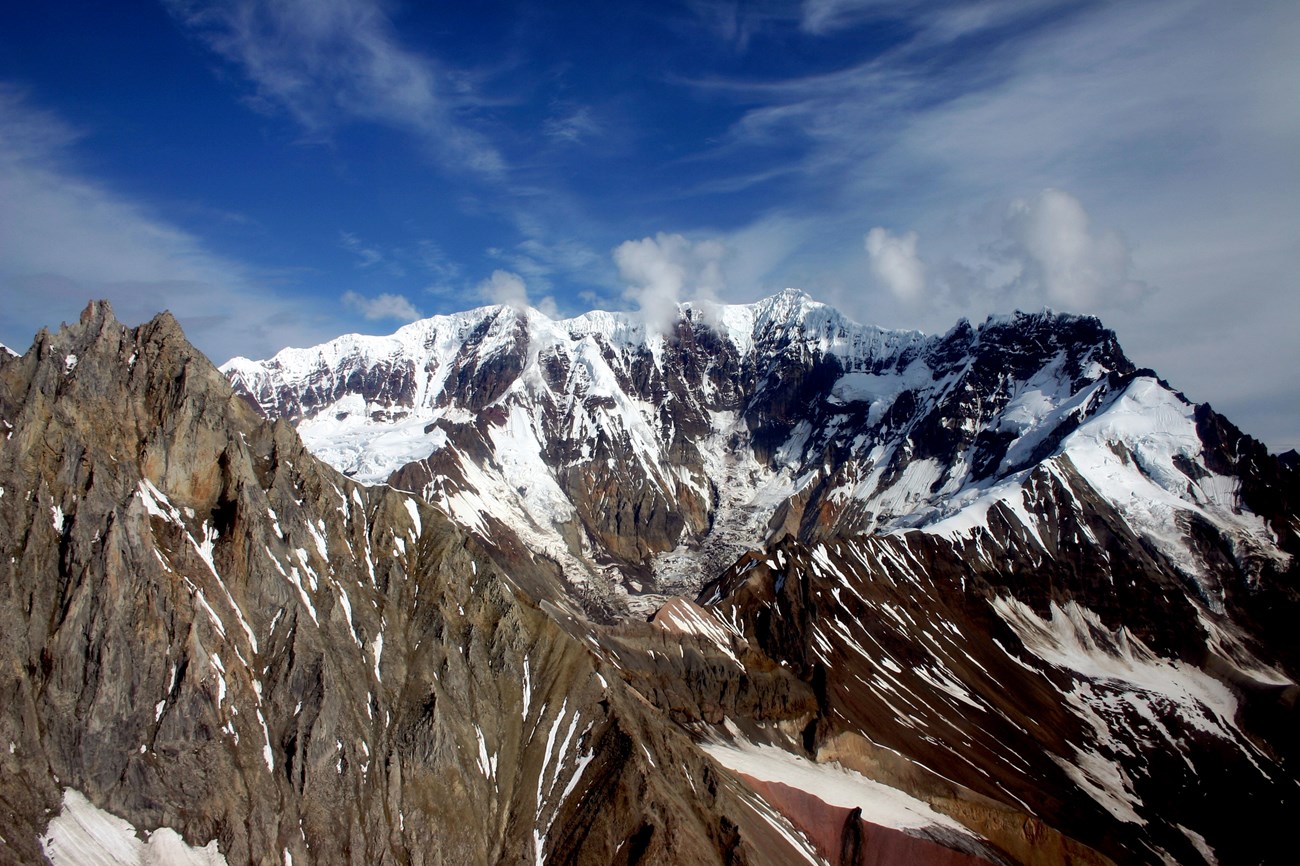
NPS Photo/ Betts and Hannan
Introduction
Extrusive igneous landforms are the result of magma coming from deep within the earth to the surface, where it cools as lava. This can happen explosively or slowly, depending on the chemical composition of the lava and whether there is an easy path for it to take to the surface. If there is not a pathway, pressure builds up over time (like a shaken soda) until the magma forcibly explodes outward.
Volcanic processes are constantly changing the Earth. Eruptions can create new islands, build and destroy mountains, and alter landscapes. Active, dormant, and ancient remnants of eruptions are all contained within our National Parks.
Types of Volcanoes
-
Shield volcanoes- Volcanoes ranging in size from small to truly massive, created by steady, non-violent outpouring of lava. Mauna Loa and Mauna Kea in Hawaii are shield volcanoes rising nearly 9 km (5.6 mi) from the seafloor.
-
Stratovolcanoes- Also known as composite volcanoes, stratovolcanoes erupt both as flows and violently. Mount St. Helens and Mount Rainier are stratovolcanoes.
-
Cinder cones- Short, steep volcanoes associated with limited eruptive events. Sunset Crater Volcano and Capulin Volcano are cinder cones.
- Lava Domes-Lava domes form where thick (viscous) magma erupts to the surface forming a steep dome-shaped landform. Lava domes can form within a crater of large composite volcano.
- Maar-Diatreme Volcanoes-maar-diatreme volcanoes are formed by the explosive result of subsurface magma coming into contact with shallow ground water. The maar is the crater landform produced by explosive eruption(s) and the diatreme is the below surface rock filled volcanic pipe or conduit.
Learn More
Volcanic Features and Landforms
Volcanic processes create many features we see when visiting the National Parks such as:
Where Volcanoes Form
There are three places that volcanism commonly occurs. These are at hot spots, spreading centers and fault zones, and subduction zones.Some of the magma produced at spreading centers erupts as lava flows and pyroclastic material, but most of it cools internally below Earth's crust. Fault zones are areas where the crust is cracking, usually due to the movement of the tectonic plates. Earthquakes and volcanism are common around fault zones.
There are no areas of active sea-floor spreading found within a national park of the United States. The country of Iceland, however, continues to grow due to the phenomenon. There are a few national parks that have evidence of past volcanism in rift valleys.
Isle Royale National Park, Michigan—[Geodiversity Atlas] [Park Home]
Keweenaw National Historical Park, Michigan—[Geodiversity Atlas] [Park Home]
Petroglyph National Monument, New Mexico—[Geodiversity Atlas] [Park Home]
The descending plate is heated by pressure and Earth's geothermal gradient. This leads to the formation of magma. The magma rises to the surface, and a belt of composite volcanoes forms. Subduction commonly generates felsic and intermediate magmas. There is not much volcanic activity at the convergence of two continental plates because continental crust is typically not dense enough to be subducted.
The volcanic activity on the Aleutian Islands and the Alaskan Peninsula is caused by subduction. The denser Pacific Plate is being subducted below the North American Plate. Visit volcanic parks in Alaska that are associated with subduction zones.
Aniakchak National Monument and Preserve—[Geodiversity Atlas] [Park Home]
Lake Clark National Park and Preserve—[Geodiversity Atlas] [Park Home]
Katmai National Park and Preserve—[Geodiversity Atlas] [Park Home]
Wrangell-St. Elias National Park and Preserve—[Geodiversity Atlas] [Park Home]
Hot spots originate deep inside Earth, so they remain stationary while the plates above them move. That is how island chains like the Hawaiian Islands are formed. The magma associated with hot spots is mafic, so shield volcanoes are commonly formed. Hot spots are also associated with many geothermal features.
The Hawaiian Islands were formed when the Pacific Plate passed over a hot spot. Yellowstone National Park is also a result of hot spot volcanism.
Hawaii Volcanoes National Park, Hawaii—[Geodiversity Atlas] [Park Home]
Haleakala National Park, Hawaii—[Geodiversity Atlas] [Park Home]
Yellowstone National Park, Wyoming, Idaho, and Montana—[Geodiversity Atlas] [Park Home]
Photo Gallery
Geological Monitoring
Visit the Parks
Last updated: February 25, 2025
